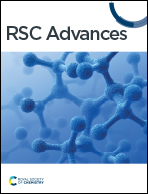Polyphosphoric acid-promoted one-pot synthesis and neuroprotective effects of flavanones against NMDA-induced injury in PC12 cells†
Abstract
We report herein an efficient polyphosphoric acid (PPA) promoted one-pot protocol for the synthesis of flavanone derivatives from 2-hydroxyacetophenones and benzaldehydes. A variety of flavanones were produced in moderate to excellent yields and evaluated for their neuroprotective effects against N-methyl-D-aspartate (NMDA)-induced excitotoxicity in PC12 cells. Derivatives bearing electron-donating groups exhibited better neuroprotective activity. Compound 3m demonstrated the best protective potency and reversed the intracellular calcium (Ca2+) influx caused by NMDA, suggesting that flavanones protected the PC12 cells against NMDA-induced neurotoxicity via inhibition of Ca2+ overload.



 Please wait while we load your content...
Please wait while we load your content...